|
June 20 – Friday (cont.)

Arriving in St. Petersburg |

Arriving in St. Petersburg |

MS Tikhi Don |

Arriving in St. Petersburg |
The captain and a couple of greeters dressed in traditional outfits are there to meet us on the gang plank. They offer us bread which we must tear off and dip in salt – a customary Russian welcome. We stop at the front desk for our keys. We were happy to get an upgrade – there are advantages to booking the cheapest room because there’s always a chance to move up.

The Crew Greets Us |

The Crew Greets Us |
We are very happy with our cabin – 230. We settle into our new home. We explore the boat, figure out the internet and go for dinner at 7. We sit with Bob and Joan and Fasil and Janet – all nice, fun people. Bill and I have the fish.

Our Cabin |

Our Cabin |

Our Cabin |

Our Cabin |
We go back to our cabin – I do the journal and Bill does the laundry. I read a small book on Stalin – now there’s one scary dude. I’m delighted to be in St. Petersburg – and to think we’ll have 3 days to explore it!
St. Petersburg – Some Background Notes
Founded in 1703, it’s gone through several names – St. Petersburg (1703 – 1914); Petrograd (1914 – 1924); Leningrad (1924 – 1991) and in 1991, back to St. Petersburg again. St. Petersburg is pretty young, compared to other Russian or European standards. It’s Russia’s largest seaport and second largest city and lies on the same parallel as Alaska
In its early days it was Peter the Great’s “Paradise” and “Northern Venice.” Tsar Peter I built the new city on a flat plain at the mouth of the Neva River and Gulf of Finland. He used the same speed and determination in putting the city together that he demonstrated when constructing boats and military fortifications. He personally oversaw the planning and layout of the city and often supervised the major edifices. Whatever he did not like was immediately torn down and rebuilt. He changed the direction, size and length of many streets and placement of several squares. In 1702, he issued an order that brought hundreds of foreigners and thousands of Russians from all parts of the country to build his new capital. (However, many of the Russians builders were slaves from the Ukraine with not choice in the matter.) News of good salaries spread through Europe and soon St. Petersburg was flooded with architects, painters, sculptors, engravers, tailors and teachers.
St. Petersburg is a city of more than 300 bridges with wrought iron railings covering 42 islands and numerous rivers and canals. 90 miles of wrought iron railings are in the city – most artfully done. It is a fabulous city. Although the city began on the northern bank, from the time of Elizabeth and Catherine the southern bank became the “in” place.
|
June 21 – Saturday – St. Petersburg
We wake up at 6:30. A pre breakfast tray of coffee, juice and a Danish is delivered to our cabin (because we’re loyal OAT / Grand Circle travelers – this is our 3rd trip with them). We drop this service after one morning because it is a pain in the butt – being served is not our forte.
We have breakfast in the dining room at 7 with a sweet couple – Denis and Betty – from Minn. The breakfast offers an omelet bar along with all the other goodies.
At 8:30, we have a ship and safety meeting. I snooze on and off throughout the presentation so I hope we don’t get into trouble on this boat because I don’t have a clue what to do.
At 10:00, we gather at the bus to take us on a tour of the city and to visit St. Isaac’s Cathedral. Our guide is Elena. She is very knowledgeable. I simply can’t believe that I am here, with elegant, magnificent city scenes of St. Petersburg, Russia passing by my bus window.
Along the banks of the Neva River we see the Admiralty and former shipyards. We also see the Palace Square with the Baroque Winter Palace, and Alexander Column (the largest column in the world built to commemorate Alexander I’s military victory in the war with Napoleon's France). I couldn’t fit my camera into the narrow bus window to capture such grandiose sights.

St. Petersburg |
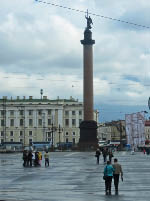
St. Petersburg |

St. Petersburg |

St. Petersburg |

St. Petersburg |

St. Petersburg |

St. Petersburg |

St. Petersburg |
We stop at St. Isaac’s Cathedral – the largest church in the city, built originally to be the main church of the Russian Empire. Peter the Great ordered the building and wanted it to be named in honor of St. Isaac because Peter shared the same birthday as Isaac (of Dalmatia). Peter the Great oversaw a very nice cathedral back in the early 1700’s. That church was replaced by a couple of more opulent ones.
The current St. Isaac’s Cathedral, largest in Russia, was ordered by Tsar Alexander I. The French-born architect, Auguste de Montferrand (1786-1858), was appointed to head up the project. Seems that Russian’s in the early days did not have faith in their own designers and architects and artists. They pulled in Italians and French for those key creative jobs. St. Isaac’s Cathedral took 40 years (1818 – 1858) to build and also took the lives of many a serf (mainly from Ukraine). It was indeed built of bones.
I couldn’t get a good angle on the church – Here’s the best I could do. The second picture is Vasily Surikov’s view of the cathedral in the late 1800’s and the Bronze Horseman in front of it. We saw this great painting on display later at the Russian Museum.

St. Isaac’s Cathedral |
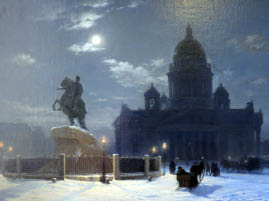
St. Isaac’s Cathedral |
The cathedral is covered with gray and pink stone. The “front porch” is truly regal huge red granite columns each made from a single block.

St. Isaac’s Cathedral |

St. Isaac’s Cathedral |
The construction was a great feat. Lifting the main columns was done with a clever pulley system which was pure genius.

St. Isaac’s Cathedral |
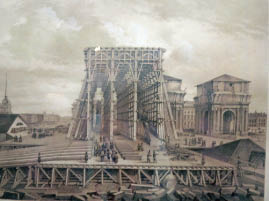
St. Isaac’s Cathedral |
The dome and other gold objects were made using a process with mercury. Unfortunately, all the craftsmen died of mercury poisoning – a bad lesson learned. The dome, which dominates the city’s skyline, is gilded with more than 220 pounds of gold and the interior is elaborately decorated with mosaics, icons, malachite and Lapis. Looking up into the dome we see a dove with a wing spread of over 6 feet. The dove looks so tiny from the main floor.

St. Isaac’s Cathedral |

St. Isaac’s Cathedral |
This is a magnificent cathedral, one of the largest in the world. Ornate with gilt, marble, murals, mosaics, sculptures, created by some of the best artists of the time.

St. Isaac’s Cathedral |

St. Isaac’s Cathedral |

St. Isaac’s Cathedral |

St. Isaac’s Cathedral |

St. Isaac’s Cathedral |

St. Isaac’s Cathedral |

St. Isaac’s Cathedral |

St. Isaac’s Cathedral |
The cathedral's doors are covered in reliefs, patterned after the celebrated doors of the Battistero di San Giovanni in Florence, designed by Lorenzo Ghiberti. He came to Russia when he was in his 20’s and spent 40 years completing the cathedral. A bust of him sits proudly in the foyer. He could not be buried in the Cathedral because he was Catholic. Instead, his remains were sent back to Italy and buried in an unmarked grave – what a shame.

St. Isaac’s Cathedral |

St. Isaac’s Cathedral |

St. Isaac’s Cathedral |
The church accommodates 14,000 standing worshippers, but it was built mainly for the royal family. Although the church closed after the 1917 Revolution, it reopened as a museum in 1931. Services started up again in 1990. I was completely blown away by its grandness and beauty.
Back on the bus, we made a quick photo stop by the Church built on spilt blood. I am excited because this is the first, real onion topped designed Russian structure I’ve ever seen. The church was built by Alexander II’s son to commemorate his father. Alexander II was passing by the area when he ordered his carriage to stop to help an injured boy -- a bad mistake. It was a trick. An assassin then threw a bomb at Alexander and he died later that night. Alexander II was a gentle Tsar and didn’t have the killing, cut throat spirit that most Russian leaders possess (e.g., Putty Put). I know Helsinki loved him because of their many statues and tributes to him. He was a kind man and wanted people to have their freedom.

Church on Spilled Blood |
We stop for lunch at a local “tour bus” restaurant. The place was packed with all us Grand Circle folks. The food – borsht, chicken salad and ice cream – wasn’t bad, especially when washed down with Vodka. Bill had to sit at another table, but got to know the most darling group of Greek gals from Washington – Molly, May, Alice and Kathy. A three of them were sisters. This is the first trip they have taken together since their husbands passed away. They were witty and fun. We liked them a lot.
After lunch is the Hermitage (part of the Winter Palace). It’s one of the largest and oldest museums in the world. Built by Peter the Great’s daughter, Elizabeth, it was later filled with the art collection of Catherine the Great. Founded in 1764, it opened its doors to the public in 1852. The Winter Palace is the most famous building of imperial St. Petersburg not only as the residence of the Tsars, but also the world’s largest museum of art. The present structure, completed in 1762 was designed by Bartolomeo Rastrelli – another Italian. Russian leaders hired foreigners for such jobs – they didn’t think their people were good enough. The palace was the winter residence for every ruler of Russia since Peter III. When the Bolshevik government transferred its capital to Moscow, the Winter Palace became associated primarily with its role as the Hermitage Museum. It has room after room of masterpieces done by artists such as da Vinci, Rembrandt, Rubens, Van Dyck, Picasso, to name a few.

The Hermitage |

The Hermitage |
The eye popping place was opulent and baroque – and crowded. I was overwhelmed by the walls and ceilings and floors and had trouble taking in the art work as well. We listened to Elena on our “whisper phones” while dashing from room to room with great new treasures to be discovered just around the corner.
Here are a few highlights of what we saw and learned:
Stairway to the Second Floor – Climbing that stairway (with very short steps) made me imagine what it was like to live in the Winter Palace, the czar’s official city residence. It was built by Italian architects (mostly Francesco Rastrelli) and in high Baroque style. The gilded walls and elaborate ceilings make me nervous – just don’t give you that lived-in, homey feel.

The Hermitage |

The Hermitage |

The Hermitage |

The Hermitage |
The Malachite Room – is a drawing room which dates back from 1837. It’s decorated with malachite, a green copper-based mineral. The room is where the czar Nicolas II was ousted in 1917 during the October Revolution (Nov. 7, 1917 on the old Julian calendar). The government took over the Winter Palace in almost bloodless coup when the communist forces loyal to Lenin and the Bolshevik Party seized power of the city. (The picture below is a malachite vase – it’s really not in the Malachite Room. The Malachite Room picts were out of focus.)

The Hermitage |
Field Marshals’ Hall – displays the portraits of Russia’s military generals – so the ruling family could keep names and faces straight!
War Gallery of 1812 – opened in 1826 to display over 300 portraits of the generals who helped get the heck out of Russia back in 1812. (Moscow was deliberately burned so that the French troops could not survive the winter. Napoleon came to conquer with 400,000 men, but only a tenth of them would make it back.) The largest portrait is of Czar Alexander I, who, by the way, ordered the creation of this gallery.

The Hermitage |

The Hermitage |
Memorial Hall of Peter the Great -- Pays homage to Peter the Great, who died in 1725, a generation before the Winter Palace’s construction.

The Hermitage |
Pavilion Room: is a large room with a throne at one end, gold gilded ceilings above, elaborate inlaid flooring and views of an outside court yard.

The Hermitage |

The Hermitage |

The Hermitage |

The Hermitage |

The Hermitage |

The Hermitage |

The Hermitage |
The room also contains the famous Peacock Clock. It’s a fun timepiece made by a British goldsmith and bought by Catherine the Great. The controls are hidden in a large mushroom. I would have loved to see it in operation.

The Hermitage |
There, we did the major historical rooms so we head to the Old Masters – mostly from the Italian Renaissance. I was not sure what all we were seeing – but here’s what I think was the most interesting and treasured in the gallery.
Leonardo da Vinci Room – Get this – there are only about 20 paintings in existence by the great da Vinci and here in the Hermitage are two of his most famous works. In these sweet little Madonna and Child scenes, he reinvented the art of painting and changed the course of art. Before these works, Madonna and Child were always large altarpieces seated formally on a throne surrounded by saints, angels, and all sorts of Glory to God stuff. Da Vinci changed that by painting Madonna and child using smaller canvases. He also focused on the emotional side with intimate portrayals of Mary in private moments with Jesus. In Leonardo’s earliest known works, “Benois Madonna” (1475-1478), Mary shows baby Jesus a flower. In his “Litta Madonna,” (1490-1491, he shows the tender moments of Mary nursing Jesus.
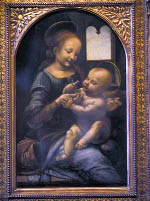
The Hermitage |

The Hermitage |
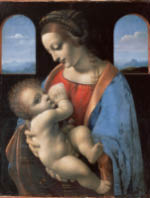
The Hermitage |
We walk in awe through a replica of Raphael Loggias. It’s a long narrow hallway, 200 feet long and only 13 feet wide, covered with colorful paintings. Raphael (and assistants) completed the fresco decorations for the Vatican in Rome in 1518-19. In the 1780’s, Catherine the Great saw engravings of this hallway and had them copied for her Winter Palace. (What do they say? Imitation is the highest form of flattery.)

The Hermitage |

The Hermitage |
Michelangelo’s sculpture -- Crouching Boy c. 1530-1534 – was intended for the base of a tomb in the Medici chapel in Florence. Don’t know how he ended up in Russia – Catherine the Great probably had something to do with it.

The Hermitage |

The Hermitage |
I was drawn to Venetian sculptor Canova’s Three Graces (1813-1816) because the statue is interesting from every single angle. How could Canova manage that when the entire sculpture is cut from a single block of marble? I like how the three girlfriends (AKA Graces) huddle, hug and exchange glances as they entertain the Greek gods at dinnertime.

The Hermitage |

The Hermitage |
Elena leads us through more galleries with more great works. She spent a lot of time in front of Rembrandt’s large-scale Danae (1636). Here the Danae waits longingly for that randy god Zeus. Of particular note is that Danae has the body of Rembrandt’s first wife (the original model) and the face of his mistress (painted over a decade later.) Catherine the Great, no stranger to bedroom visitors, bought this painting in 1772. Elena told us that in 1985, a crazy visitor threw acid on Danae’s face causing a lot of damage. They did a great job of restoring the painting. Elena said the de-facer lives happily in a mental institution on the state dole.
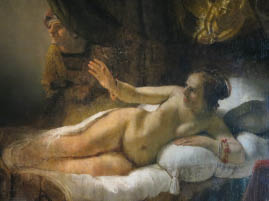
The Hermitage |

The Hermitage |
Rembrandt painted The Prodigal Son in 1669. Lots of artists had a stab at this Bible story of a young wild son returning home to ask for forgiveness from his father. Rembrandt shows us a Dad with gentle, non-judgmental emotions with a tender embrace. The Prodigal Son was one of Rembrandt’s last paintings and reveals his own life story into the painting. He was a young, wild prodigy whose great talent brought him fame, wealth and women and song. In the end, he lost it all and spent his last years in relative poverty.

The Hermitage |

The Hermitage |
Finally, at 3 pm, Elea ends our tour. Most were museum-ed out, but Bill and I didn’t want to miss the impressionistic paintings on the 3th floor. We made a quick bathroom stop and hooked up with our buddies Bob and Joan to see the works of “The Modern Masters” -- Picasso, Monet, Van Gough, Rodin, etc. Many of these works became public museum pieces when the Soviet Union nationalized the collections of rich businessmen so that the proletariat could enjoy them – Thank you Soviet Union for something good.
So many canvases are crammed into small rooms on the 3rd floor that it’s hard to keep track of who’s who. Here are just a few of the many famous.
Edouard Manet (1832-1883) – bucked the system, dropped the goddesses and painted realistic scenes of everyday life.
Edgar Degas (1834-1917), inspired by Manet, sketched candid snapshots of modern life in Paris.
Claude Monet (1840 – 1926) and his close buddy Auguste Renoir (1841 - 1919) took it another step, setting up their canvases outdoors to capture the scenes in real light. They became the founding fathers of Impressionism.

Joan and Bob study Monet’s strokes |

Joan studies somebody else’s strokes |

Renoir – Young Girls at a Piano (1892) |

Renoir |
Vincent van Gogh (1853 – 1890), that crazy Dutchman, added swirling brushwork launching the Post-Impressionist style.

Vincent van Gogh – His mother and sister in a garden from his childhood |

Vincent van Gogh – Thatched Cottages |
Paul Gauguin (1848 - 1903) adopted his pal van Gogh’s style, but added more color and simplified forms to give this work that primitive tribal art look and feel.

Paul Gauguin – 1892 – from his first stay in Tahiti |

Paul Gauguin – 1893 – Woman Holding a Fruit – simple pleasures of life |
Henri Matisse (1869 – 1954) took it even further with the brighter colors and simpler forms, creating the art of “wild beasts” (Fauves).
Paul Cezanne (1839 – 1906) – a struggling artist, rejected 3-D to compose paintings as geometrical blocks of color.

The Hermitage |
Finally, with the dawn of the 20th Century, Pablo Picasso (1881 – 1973) broke up Cezanne’s blocks into chards and “cubes” of color, all jumbled up, creating purely abstract art.

Picasso – The Absinthe Drinker 1901 – a woman in a grimy café contemplating her fate |

Typical Picasso that we all have come to love |
Picasso was absolutely the most versatile artist – and worked in all manner of media. There was a fascinating collection of his ceramic pictures.

Picasso--The Hermitage |

Picasso--The Hermitage |

Picasso--The Hermitage |
The viewing marathon is over at 5 – I was exhausted. We gathered to find a Grand Circle rep to lead us to the bus and then back to the ship. It takes an additional 20 minutes to locate a few lost souls.

Joan and Bob |

The Hermitage |
By the time we get back to the ship we were totally brain dead – only a beer with some pals at the ship’s bar could make it right again … and it did. Dinner at 7 – We sat with Bob and Joan and enjoyed our meal of lamb, potatoes and veggies. (It was Janet’s birthday today – She’s 69.)
We come back to the cabin – me to write the journal and Bill to wash the clothes. Then I settled in to read a book about Nicholas, the last Czar. I am hooked on Russia.
June 22 – Sunday – St. Petersburg
Wake up at 7 and head for breakfast. It is a glorious sunny day – hope springs eternal.
We load on the buses at about 9 and drive to a little town in the suburbs of St. Petersburg called Pushkin. It is serene with lots of grass and trees and the home of Catherine Palace / Museum. It is also the town where Russia’s greatest writer lived – Aleksandr Pushkin.

Aleksandr Pushkin |

Aleksandr Pushkin |

Pushkin's School |
He went to school in this little town before it was called Pushkin. Several plaques on the school building commemorate his life as a student. He was lousy in math, but a literary genius. He was a descendant of a black man (who was a confident of one of the royals). He married and had 4 children. However, at age 38, challenged to a duel to defend his wife’s honor, he was mortally wounded. The country was devastated. We walk pass a park dedicated to him.
Next we visit Catherine’s Palace, called the Versailles of Russia. The palace constructed in blue, white and gold was named for Empress Catherine I who ordered its construction in 1717. It totally blew us away. The palace, dripping in the grand Baroque façade, was designed by Italian architect Rastrelli – who also designed the Winter Palace. Catherine the Great, who disliked Baroque style, fired Rastrelli as soon as she came to power.
We are greeted by a 4 guys constituting a band and playing American music (and selling their CD’s as well). They look a little tattered, but sound great. They implant the melody of “Blue Moon” in my brain and have me singing it all day.

Catherine’s Palace |

Catherine’s Palace |

Catherine’s Palace |

Catherine’s Palace |

Catherine’s Palace |

Catherine’s Palace |
Elena guides us through the palace loaded with exquisite decorative objects, furniture, Russian and West-European paintings, collections of porcelain, amber, arms and bronze sculptures. Each room of the palace was more opulent and exquisite than the last one, each with the gold and mirrors and clocks and table decorations and settings – and the parquet floors were works of art. We wear booties over our shoes to protect their beauty.
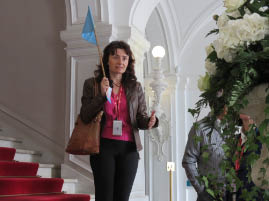
Catherine’s Palace |

Catherine’s Palace |

Catherine’s Palace |

Catherine’s Palace |

Catherine’s Palace |

Catherine’s Palace |

Catherine’s Palace |

Catherine’s Palace |

Catherine’s Palace |

Catherine’s Palace |
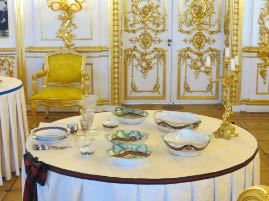
Catherine’s Palace |

Catherine’s Palace |

Catherine’s Palace |

Catherine’s Palace |

Catherine’s Palace |

Catherine’s Palace |
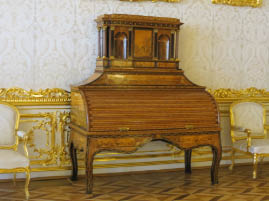
Catherine’s Palace |

Catherine’s Palace |
The true glory of the palace is the amber room. The room is made of several tons of the golden tree resin – the lightest gem in the world. Some architect came up with the idea of decorating the walls with amber. It was first displayed in Peter’s Winter Palace. Empress Elizabeth ordered the amber panels to be transferred to the Catherine Palace. The panels were not large enough to cover the entire wall, so mosaic and mirror insets were added – four of them contain pictures made of semiprecious stones like quartz, jasmine, jade and onyx. In 1941, when Nazi troops were approaching Leningrad, hasty plans were made to evacuate the treasures to a safer place. But the amber room was too fragile, so it was decided to hide it under double walls with inferior paintings quickly slapped up on them. The German troops occupying Catherine Palace discovered the fake walls so the walls of the amber room were packed into boxes and evacuated. They were lost, never to be found again – a true mystery. The new amber room was constructed and opened on May 31, 2003 as a cost of $11 million dollars. 6 tons of raw amber were needed for the construction.
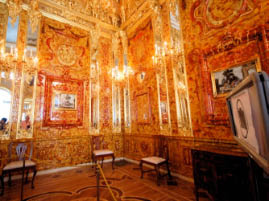
Amber Room Catherine's Palace |
We pass a hallway showing how badly the palace was damaged by the Germans – and the following years where workers poured their hearts into restoring this magnificent palace. Elena said that the funds for the restoration were quickly because regaining these treasures was a great source of national pride – very important to the people.

Restoration of the Amber Room |

Restoration of the Amber Room |
After an hour in relatively few crowds, we are done with the palace. We have time for a bathroom break and short shopping spree before we hit the gardens out back.

Gift Shop at Catherine's Palace |
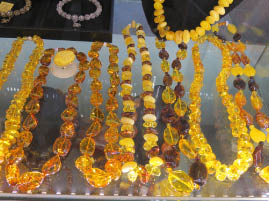
Gift Shop at Catherine's Palace |
The sunshine with blue skies dotted with a few white clouds is a perfect backdrop for Catherine Palace. We say good-bye to the palace and start in the English garden where Catherine strolled every morning in her sexy nigh gown with her favorite dog. She thought she was alone, but the guards hid out and enjoyed the show.
Catherine’s garden and park occupies almost 50 square miles with over 100 architectural constructions – from magnificent palaces, a manmade lake, grand monuments, hidden bridges, pavilions and other park stuff. We had our group photo taken in the park – everyone was in good spirits.

Catherine's Palace |
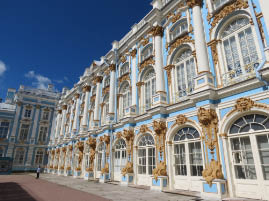
Catherine's Palace |

Gardens at Catherine's Palace |

Gardens at Catherine's Palace |

Gardens at Catherine's Palace |

Gardens at Catherine's Palace |

Gardens at Catherine's Palace |

Gardens at Catherine's Palace |

Gardens at Catherine's Palace |

Gardens at Catherine's Palace |

Gardens at Catherine's Palace |

Gardens at Catherine's Palace |

Gardens at Catherine's Palace |

Gardens at Catherine's Palace |

Gardens at Catherine's Palace |

Gardens at Catherine's Palace |
We board our bus -- the blue team bus -- and head back to the ship for lunch. I really enjoy the lunch --what’s new? It’s pasta, soup, garden salad and peach ice cream. We sit with Fasil, Janet and Kathy.
After lunch, we have a ship safety drill and don our life jackets. We looked silly and struggled passing each other in the hall.
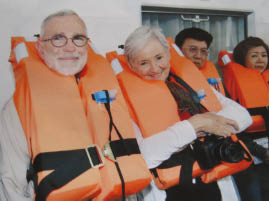
Safety Drill |

Safety Drill |

Safety Drill |

Safety Drill |
At 3, we take the informal “friendly metro / subway tour” into town. A regular bus, Bus #116 close to our ship, picks us up and carries us to a Metro station. At the metro station, we pay 3 rubles (approx. $1) to buy a token and hop on the underground and ride into the center of St. Petersburg – 4 quick stops and we’re there. We walk up from the metro and then out onto the main street, Nevsky Prospect to explore St. Petersburg on foot.

Exploring St. Petersburg |

Exploring St. Petersburg |

Exploring St. Petersburg |

Exploring St. Petersburg |

Exploring St. Petersburg |

Exploring St. Petersburg |

Exploring St. Petersburg |

Exploring St. Petersburg |
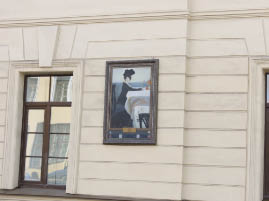
Exploring St. Petersburg |

Exploring St. Petersburg |

Exploring St. Petersburg |

Exploring St. Petersburg |
We turn right on Nevsky Prospect and head down the canal to see The Church of our Savior on Spilled Blood. We walked along a lovely canal taking pictures of the magnificent church. During the Soviet “godless years,” the magnificent church was used as a potato warehouse and scheduled to be destroyed. 3 dollars buys us entrance inside the church.

Exploring St. Petersburg |

Exploring St. Petersburg |

Exploring St. Petersburg |

Exploring St. Petersburg |

Exploring St. Petersburg |

Exploring St. Petersburg |
The church was built as a memorial on the exact site where a terrorist from the revolutionary organization People’s Will named Grinevitshky, killed Tsar Alexander II. On March 1, 1881, Grinevitshky tossed a bomb at his feet and he died later. Tsar Alexander II was the only kind gentle Tsar, but was perceived as weak.
The church was modeled after St. Basil’s in Moscow’s Red Square. It took 24 years to build and 27 years to restore. When we entered the sanctuary, I was overwhelmed with a mind-boggling 75,320 square feet of mosaics sparkling in the filtered sunlight. This is absolutely the most beautiful church ANYWHERE, bar none.
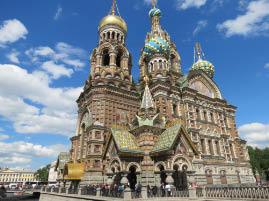
The Church of our Savior on Spilled Blood |

The Church of our Savior on Spilled Blood |

The Church of our Savior on Spilled Blood |

The Church of our Savior on Spilled Blood |

The Church of our Savior on Spilled Blood |
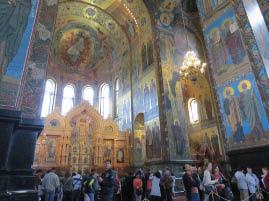
The Church of our Savior on Spilled Blood |

The Church of our Savior on Spilled Blood |

The Church of our Savior on Spilled Blood |

The Church of our Savior on Spilled Blood |

The Church of our Savior on Spilled Blood |

The Church of our Savior on Spilled Blood |

The Church of our Savior on Spilled Blood |

The Church of our Savior on Spilled Blood |
NOTE: Just had to post this picture -- the exact spot Alexander II was mortally wounded. Sorry those raindrops keep falling on my lens. The designer was so precise about building the church over Alexander II’s spilled blood that he insisted on screwing up the city streets and even cutting into the canal.

The Church of our Savior on Spilled Blood |
We emerge from the church into the glorious, sunny, Sunday afternoon. Everyone (and their monkey) is out enjoying the street scene. There were several musicians with quirky shows. I liked the trumpet player standing on a pillar along the canal. He played the U.S. national anthem. I thought I detected a few ‘boo’s” – but I tend to have an overly active imagination.

Streets of St. Petersburg |

Streets of St. Petersburg |

Streets of St. Petersburg |

Streets of St. Petersburg |

Streets of St. Petersburg |

Streets of St. Petersburg |

Streets of St. Petersburg |

Streets of St. Petersburg |
We buy a single rose from a student to take back to Oksana at the Reception Desk. I immediately connect with Oksana at the main desk on the ship and told her I’d bring her a surprise.

Streets of St. Petersburg |
We have a few minutes to regroup before we get ready for dinner. We enjoy our evening with the Greek gals from the Seattle area – Molly, Alice, Kathy and May. I had soup, turkey (and dressing) and a most delicious chocolate cake with strawberry ice cream. Can life get any better than this?
June 23 – Monday – St. Petersburg
Rain, rain – GO AWAY! A day on our own.
Had a nice breakfast – made a couple of cheese and ham sandwiches to take along to St. Petersburg … just in case.
We leave the ship about 9 with about 20 people. Asia, the guide, gets us on the #119 bus to the metro station. From the station, she makes sure we all get on the metro train. Once in the city center on Nevsky Prospect, we say good-bye, but the rest of the gang hangs with her and heads to The Church on Spilled Blood. We take off for the Russian Museum. It’s drizzly and yucky, but we’re gonna have fun no matter what.
We spend almost 4 hours in the art museum. The museum occupies the Mikhailovsky Palace, built for the Grand Duke Mikhail Pavlovich, grandson of Catherine the Great in the 1820’s. The rooms were impressive, but not grandiose like those at the Hermitage.

Russian Museum | 
Russian Museum |

Russian Museum | 
Grand Duke Mikhail Pavlovich |

Russian Museum | 
Russian Museum |

Russian Museum | 
Kazimir Malevich, Black Square, c. 1923, Oil |
The museum has 109 numbered rooms which lead you along a timeline – from the Russian icons dating back to the 1100’s with roots in Medieval Greek and Byzantine styles.

Russian Museum | 
Russian Museum |
One large gallery room held a painting of the 100th session of the State Council of Imperial Russia (conducted in The Marie Palace on May 5, 1901). I am fascinated by the room and Nicholas II, the last czar. Repin was commissioned by the Russian government in 1903 to produce such a grandiose painting.

Russian Museum |

Russian Museum |

Russian Museum |
We see a mind boggling collection of Russian art, particularly 18th and 19th century paintings. The Hermitage has mostly Western European art and wasn’t that different for us – but the artwork here has a new feel about it – focusing on their own culture and landscape, marshes, muddy streets, Siberia, etc. You can really feel the turbulent political history when you enter the rooms covering 1870 – 1940. First the end of serfdom and agitation for social change and equality; later WWI, industrialization and the beginnings of communism. Mingled in were the currents of Impressionism, Art Nouveau and Modernism that came in from the West.
I took a ga-zillion photos. Bill asked me what I planned to do with all the pictures – ANSWER: I don’t know. I enjoyed studying them and capturing them before my camera’s lens. Here are my top picks of art that isn’t so familiar in my Western world.

Russian Museum |

Russian Museum |
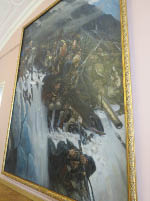
Russian Museum |

Russian Museum |

Russian Museum |

Russian Museum |

Russian Museum |

Mark Chagall – Promenade 1917 |

Russian Museum |

Russian Museum |
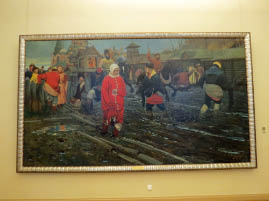
Russian Museum |

Russian Museum |

Russian Museum |

Russian Museum |

Russian Museum |

Russian Museum |

Russian Museum |

Russian Museum |

Russian Museum |

Russian Museum |

Russian Museum |

Russian Museum |

Russian Museum |
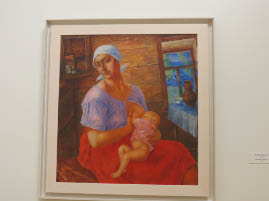
Russian Museum |

Russian Museum |

Russian Museum |

Russian Museum |
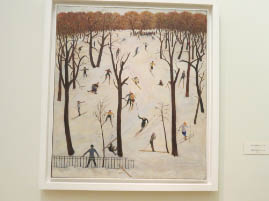
Russian Museum |

Alexei Sundukov’s I (1986) |

Russian Museum |

Russian Museum |

Russian Museum |

Russian Museum |
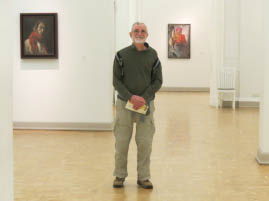
Russian Museum |

Russian Museum |

Russian Museum |

Russian Museum |

Russian Museum |

Russian Museum |
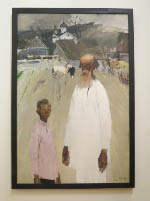
Russian Museum |

Russian Museum |

Russian Museum |

Russian Museum |

Russian Museum |

Russian Museum |

Russian Museum |
About 1:00, we finish the last room of the museum and we were finished, too. Brain dead and exhausted, we have tea in the museum café and eat the sandwiches I made from breakfast. We hate to go back out into the bad weather. The Ethnographical Museum, next on our list, is closed on Mondays, so we trudge on to Plan B – Pushkin’s house. There is not one word of English in any of the signs – but we know it’s the place because we recognize his statue from yesterday – a thin man with curly hair and thick lips. The ticket office is packed with people and no ticket seller – so we bag that idea and head to Palace Square.

Pushkin |

St. Petersburg |
Peeping from under my umbrella, when it’s not blown inside out, I see such things as the Hermitage and the landmark Alexander Column in the center of the square. It is 82 feet tall and cut from a single piece of granite. Its pedestal weighs 650 tons and stands on its own weight. On the top is an angel crushing a snake – symbolizing Russia’s victory over Napoleon – a very big deal.

St. Petersburg |

St. Petersburg |

St. Petersburg |

Alexander Column |
We head back to the main drag, Nevsky Prospect, and search for the Kazan Cathedral in the continual rain. Bill’s map quickly becomes soggy. I want to take pictures of what I think is a war memorial right across the street next to the Griboyedova Canal. I snap a few photos – but Bill is determined to find the church and get out of the rain. We walk a little ways down Nevsky Prospect. I duck into another church right in the center of an artist colony. This one happens to be a Catholic Church – in fact, one of the oldest Catholic churches in Russia. When Peter the Great offered religious freedom to the Catholics in 1710, he built a modest Catholic church in the then-Greek suburb. Later, Catherine the Great built another church, much bigger and nicer, and named it Catherine Catholic Church. During her reign she built many churches.
We enter the Catholic Church and immediately noticed the difference from the many Russian Orthodox churches we’ve seen. I like the simple and sweet design, void of lots of gaudy icons. The place also offers pews to sit in – a real plus, in my opinion

Catholic Church |

Catholic Church |
Catholic and Orthodox Churches – Main Differences
Catholic and Orthodox churches are similar, but many of the rituals and customs are different. When entering an active Russian Orthodox Church (much like the Catholic church), you usually drop a coin in a box, pick up a candle, say a prayer, light the candle and put it in the candelabra, then make the sign of a cross and kiss an icon.
Russian Orthodox Churches don’t have regular “altars” that we are used to. Rather they come with an altar screen covered with curtains and icons (iconostasis). There’s a standard design calling for four icons flanking the central door – Jesus on the right, then John the Baptist and Mary with Baby Jesus on the left. One special icon that depicts either the saint or event that the church is dedicated to is on the far left.
The Iconostasis separates the lay community from the priests – the material world from the spiritual one. Behind the Iconostasis, the priests turn bread and wine into the body and blood of Jesus – then they open their doors (or curtains) and serve the flock.
The Orthodox faith tends to use a Greek cross with four equal arms (sometimes with a circle added) while the Catholic uses the longer Latin cross to evoke images of the Crucifixion.
There are few, if any, pews in a Russian Orthodox Church. Worshippers stand through the service to sign respect – although they let the elderly sit on benches along the walls. Traditionally, women stand on the left, men on the right.
Orthodox icons (paintings of saints) are not intended to be lifelike. They are loaded with symbols against a shimmering golden background. They focus on the spiritual nature rather than the physical form. Most Eastern Orthodox churches have at least one mosaic or painting of Christ in a standard pose.
Orthodox services general involve chanting between the priest and the congregation and the church is filled with incense. This is to help the worshipper transcend the physical world and enter the spiritual one. |
During our quiet respite out of the rain seated in the Catherine Catholic Church, Bill double checks the map to pinpoint exactly where the Kazan Cathedral is located. It is then when we discover that what we thought was the war memorial is actually the Kazan Cathedral. It is listed on the map as a “Museum of Atheism,” which explains a lot. Now the Kazan Cathedral is designated as an active church.
Russia Church – Active or Museum
We were surprised to find 2 different types of churches in Russia – museum or active. Women must cover their heads in active houses of worship – while museums had fewer restrictions. Under communism, the state religion – atheism – became the main belief. Many churches were seized by the government – some destroyed and some re-purposed into such things as swimming pools or ice-hockey rinks. Stalin was big on destroying churches – blowing up some and burning some to the ground. A swell of protest came from the public and he relented on his church destruction rampage. He made most of the remaining churches into storage buildings with no services allowed. They were reopened during Gorbechev's era and restored as necessary. Since the fall of communism, Russians have flocked back to their church and restoration is in full swing. Three out of every four Russian citizens follow a faith. Even Putin claims he was a closet Christian all those years during his dark KGB days. |
We put our rain gear on and retrace our steps back to the Kazan Cathedral (formerly known as the “Museum of Atheism”). The entrance has a sweeping exterior portico modeled after St. Peter’s in Rome with a proud statue of Field Marshal Mikhail Kutuzov (1745-1813) who lead the Russian troops to a victory over Napoleon in the War of 1812.

Kazan Cathedral |

Kazan Cathedral |

Kazan Cathedral |

Kazan Cathedral |
Here’s just some of the interesting things we saw inside:

Kazan Cathedral |

Kazan Cathedral |
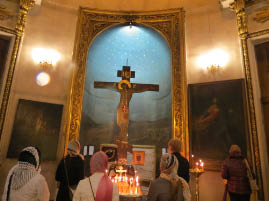
Kazan Cathedral |

Kazan Cathedral |

Kazan Cathedral |

The brilliant silver-arched iconostasis – the main altar |
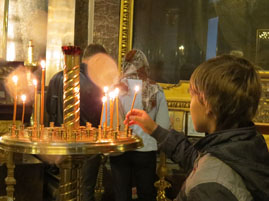
Lighting candles |
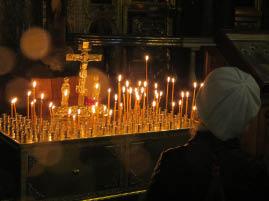
Lighting candles |

Kissing the replica of “Icon of Our Lady of Kazan” |

Kissing the replica of “Icon of Our Lady of Kazan” |

Icons |
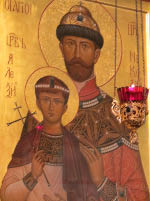
Icon of Nicholas II and his son |
We leave the church and head back to the metro station. I trip and almost break my neck on the slick stone streets. Somebody (or one those icons) is surely watching out for me. When I’m not falling, I snap a few photos of the city in the rain with people dashing about with their umbrellas. I like it here, rain or shine.

St. Petersburg |

St. Petersburg |

Old Singer Building – now a bookstore |
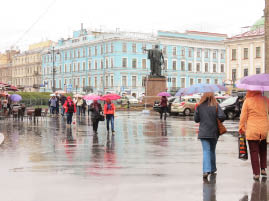
St. Petersburg |
We come to the shopping center above our metro station and frantically search for a bathroom. I like the shopping center. The manikins and photos of the fashion models are of ugly / ordinary people which I find very refreshing. I also like the pure craziness of Russia.

St. Petersburg |

St. Petersburg |

St. Petersburg |

St. Petersburg |
We find Ann and Denis in the metro station on our way back to the ship. Ann is excited because she got to meet with a guy who is in charge of mammoths in Russia. We are too tired to join in her enthusiasm.
After the quick metro ride, we catch the bus, and then finally, walk to the ship. Happy hour beer was a most welcomed sight.
Before dinner, I study the travel guides to find out what we saw today. We eat at 7:00 – I have the fish. Bill has the veggie lasagna. We all have the soup – These guys can really make soup. (Makes me miss Nadia’s soup.)
We hang out at the table with Peter and Leslie, another NiNi and Papa – then Joan joins us. We want to stay longer, but out come the vacuum cleaners. Time to go back to my room and journal! Tomorrow is our last day in St. Petersburg.
June 24 – Tuesday – Last Day in St. Petersburg
All aboard the bus for the Peter and Paul Fortress – the number 1 monument to Peter the Great’s reign. On May 17, 1703 (duded the city’s birthday), Peter I laid the foundations of this fortress on an island in the Neva River to defend this strategic point where the waterways of Russia and the Baltic (and therefore, the rest of Europe) meet. The fort was also on a critical trade route location. From here, Peter the Great was able to protect his future city especially from the Swedish armies during the Great Northern Wars.
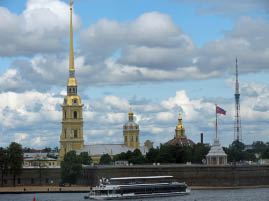
Peter and Paul Fortress |
Peter and Paul fortress was designed by Peter the Great. In the late 19th and early 20th centuries, the czars held political prisoners here in the Trubetskoy Bastion Prison – such as Dostoyevsky, Trotsky, Gorky and Lenin’s brother. When they came into power, the Soviets closed the prison, so now it’s a just a museum. (Putin would probably have it reopened for journalists and Pussy Riot types.) We didn’t visit the prison.
We wait in long line to visit St. Peter and Paul Cathedral, the centerpiece of the fortress. While waiting, I roam around snapping photos of the Peter’s boat house, a Russian mint house (very busy at the time of the wealthy czars), the prison and the St. Peter and Paul Cathedral. Unlike the typical onion domes, this cathedral has long, shiny, skinny spire (about 400”) topped with an angel holding a cross – the symbol of the city.

Peter and Paul Fortress |

Peter and Paul Fortress |

Peter and Paul Fortress |

The Mint |

Peter the Great’s Boat House |

Peter and Paul Fortress |
Finally we enter the crowded cathedral. It’s mostly famous as the final resting place of the Romanov czars who ruled Russia from 1613 through 1917. It is magnificent – with big, tall windows filling the place with light, unlike the typical dreary Russian Orthodox churches. There were shinny statues (more like a catholic church) and a lovely pulpit – although no one preached from the pulpit because it was an Orthodox church. However, Trotsky was excommunicated from that very pulpit, although, he didn’t care.

Peter and Paul Cathedral |
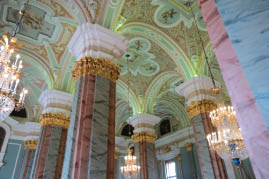
Peter and Paul Cathedral |

Peter and Paul Cathedral |

Peter and Paul Cathedral |

Peter and Paul Cathedral |
The iconostasis at Peter and Paul Cathedral is unique. Usually the iconostasis is a flat panel that separates the altar from the rest of the church, but here, it towers and forms a tower. Below the iconostasis and to the right is Peter the Great’s Tomb, topped by a bust of him. (By the way, Peter’s son, Alexei Petrovich (1690 – 1718) is buried in the cathedral. He was in cahoots with a group who planned to overthrow Peter and tortured to death by his own father.)

Towering Iconostasis |

Peter I’s Grave (under the Bust) |
All the Russian emperors and empresses are buried here. Even the last of the Romanov family (Nicholas II, Alexandra and their 5 children) were laid to rest here. They were executed in 1918 and originally buried in an unmarked grave. Their remains were discovered in 1991 and reburied in the cathedral in 1998. They each have a white, simple, marble coffin to rest in peace. The hallway features the graves of the siblings of the czars – Grand Dukes and Grand Duchesses.

Peter and Paul Cathedral |

Peter and Paul Cathedral |

Peter and Paul Cathedral |

Peter and Paul Cathedral |
The picture of the last Czar’s mother, Maria Fedorovna (1847 – 1928) was displayed by her coffin. Her picture is also over our bed in our cabin on the boat. She was a Danish princess who moved from Copenhagen to St. Petersburg, married the second-to-the-last czar (Alexander III) and gave birth to the last czar (Nicholas II). He inherited her short genes – the only little guy in a clan of tall men. Although he ruled Russia, he often said, “Nobody wants to take orders from a midget.” After the October Revolution, Maria wisely fled to live in exile in Denmark. In 2006, her remains were brought back here to rest in peace, reunited with the last czar, her short son Nicholas II, his wife Alexandra and their 5 children – all executed. Gets to you.

Maria Fedorovna Crypt |
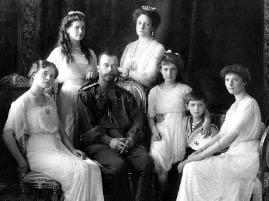
The Romanovs – The Last Royal Family (in livelier times) From left to right: Olga. Maria, Papa Nicholas II, Mama Alexandra, Anastasaia, Alexei and Tatiana |
We left the fortress on the island and saw where the locals sunbath on those rare sunny days. According to our guide, the locals are like polar bears and don’t mind the cold,

Along the River |

Along the River |
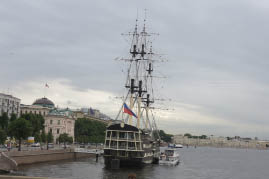
Along the River |

Along the River |
After our visit, the bus drove us into downtown St. Petersburg. On our own for lunch, we hook up with Joan and Bob and roam the streets cursing the drizzle and the crappy weather. Bob is hungry for a burger and fries, but the rest of us have sandwiches we made from the ship’s breakfast buffet. The sun finally broke through and we are able to eat our lunch outside in the shadow of the Church on the Spilled Blood – my favorite.

Church on the Spilled Blood |

Joan and Bob |
We walk on down to our group meeting place -- an expensive souvenir shop. There’s always a bathroom in a reputable souvenir shop. The Hunt for Red Bathroom gave me the giggles – Don’t know why it struck me as funny! My poor friend.
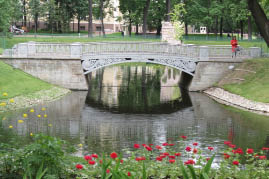
Mikhailovsky Garden |

Mikhailovsky Garden |
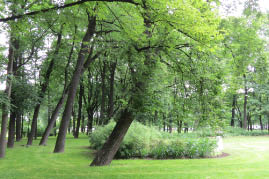
Mikhailovsky Garden |
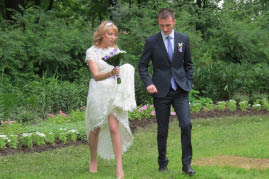
Mikhailovsky Garden |
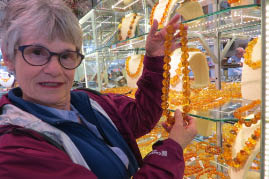
Joan in Souvenir Shop |

Souvenir Shop |
We load on the bus and head to Peterhof, about an hour’s drive away. It sits along te Gulf of Finland, west of the city. It was Peter’s lavish palace and later became the summer residence of the Russian royalty called “Versailles by the Sea.” Started in 1714 by Peter I, the place evolved into a grand palace atop the hill surrounded by a park as well as several other smaller palaces. Versailles inspired Peter the Great to build the Peterhof. Only he made it much better than Versailles.
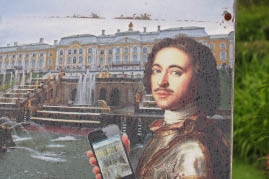
Peter in Front of Peterhof with his Audio Guide |

Peterhof |

Peterhof |
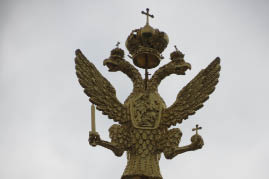
Peterhof |

Peterhof |

Peterhof |
Later on Peter the Great’s daughter, Empress Elizabeth, expanded the grand palace and gardens, including the Grand Cascade – a fountain made up of 3 waterfalls with 150 fountains shooting more than 2,000 jets of water from a myriad of statues and sculptures. The Promenade, running along the Grand Canal to the boat dock on the Gulf of Finland, is terraced with elegant statues and fountains.

Peterhof |

Peterhof |
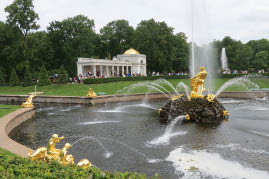
Peterhof |

Peterhof |

Peterhof |

Peterhof |
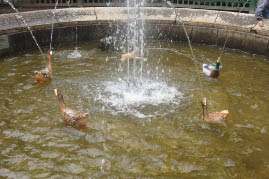
Peterhof |

All the way to the Gulf of Finland |
The garden waterworks, after more than 250 years, continue to operate over 13 miles without pumps, relying on gravity. (The guide explained the process – but I still didn’t get it.) Peter the Great had a great sense of humor and designed some joke fountains that would spray unsuspecting guests. There are very clever fountains scattered throughout the grounds.
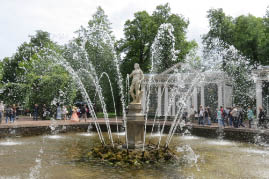
Step on the wrong stone and you get splashed |

Step on the wrong stone and you get splashed |

Peterhof |

Peterhof |
We visit Catherine’s Wing, one of the smaller palaces, that once was the party house for Elizabeth. We put on our booties to tour the lavish rooms. I am semi-happy that no photos are allowed so I could BE IN THE ROOM, not BE WITH MY CAMERA. Nonetheless, I only have sketchy recollections of the palace. One room was the recital hall where Elizabeth (or was it Catherine?) who started the first finishing school for girls. The girls graduated into “ladies in waiting” and married into wealth and power.
NOTE: We learned that the Nazis took over the Peterhof during WW II. Before they left (by force), they destroyed as much as they could and then scattered land mines throughout the garden. They made a mess of things – but the Russians restored it to its former beauty.

Peterhof |
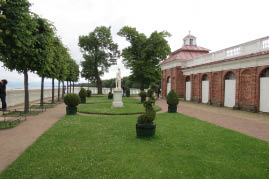
Peterhof |
Elizabeth liked to party and show off and even cook for her guests. She was the opposite of her father, Peter the Great. She must have driven him nuts. True story -- Peter the Great dies rather suddenly from a cold. Just before he died, he started to write on a piece of paper … “I want the next ruler to be …” but never finished the sentence. No one knew who he wanted to replace him. The powers that be selected Elizabeth as the next ruler. Peter the Great must have been turning in his grave. When Elizabeth finished her reign, she had accumulated a lot of dresses and shoes – but only had 3 rubles in the treasury coffers.
A Little Side Story about Catherine the Great – optional reading
Peter the Great’s daughter, Elizabeth was unmarried and childless. She chose her nephew, Peter, as heir to the throne after her. Elizabeth searched for a prospective bride for the nephew. She adopted Catherine, a German gal and groomed her for the marriage.
Catherine II of Russia, who would become Catherine the Great (1729-1796), turned out to be one of history's most astute and skillful rulers in Russia's long, turbulent history. After marrying Elizabeth’s nephew, Peter from Russia's Romanov family, she was part of a coup that forced Peter to abdicate just six months after he became czar leaving Catherine as the sole ruler. Later, Peter was murdered by Alexei Orlov, the brother of Catherine’s current lover Gregory. Makes you wonder. She was an excellent ruler for 34 years, in spite of her scandalous personal life. She was very clever and faced down more than a dozen uprisings during her reign.
Story goes that Catherine and Peter had little, if no sex life. Eight years passed without an heir to the throne. Some believe Peter was unable to have sex while others think he was infertile. Catherine played around a lot. In 1754, when she produced a son, Paul, everyone thought the father was Sergei Saltykov, a Russian military officer. Catherine’s three additional children were clearly not fathered by Peter.
Catherine was loyal to her lovers, both during their relationship and after it ended. Always parting on good terms, she gave titles, land, palaces and even people (i.e. serfs). Not a bad deal for bedding Catherine.
Catherine got the empire rolling again with vast territorial expansion, adding greatly to Russia’s coffers. In spite of the fact that she did little to help the suffering of her people, she considered herself to be one of Europe’s most enlightened rulers. She was indeed a Renaissance woman – writing numerous books, pamphlets and educational materials to improve Russia’s education system. She loved the arts, keeping up a lifelong correspondence with Voltaire and other prominent minds of the era, creating one of the world’s most impressive art collections in St. Petersburg’s Winter Palace (now the Hermitage Museum). She even tried her hand at composing opera.
Catherine had a famously stormy relationship with her eldest son, Paul and had little to do with him. It was clear she wanted one of his sons (her grandchildren) to be next in line, but she died before she made it official. Paul became czar but was as erratic and unpopular as Catherine had feared. Five years into his reign, he was assassinated, and his 23-year-old son assumed power as Alexander I. Catherine’s life fascinates me. |
After the palace, we walk through the “back 40,” circling from the dock to the massive gardens before returning to the main house at the Peterhof. The grounds were busy – lots of people and lots of activity. A big concert was setting up for an evening party. A couple of gals in the band were “Pussy Riot” wanna bees. We found our way to the bus, weaving through lots of young graduates – such a fun time and fun place – and only a few sprinkles.
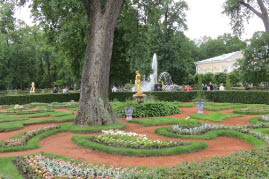
Peterhof |

Peterhof |

Peterhof |

Fountain Trees |
 |
 |
Visitors try to throw coins into the top of this Military Guy’s
boots (from the back) |

Peterhof |

Peterhof |
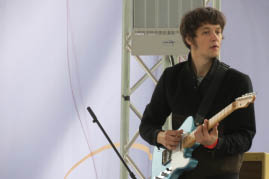
Peterhof |
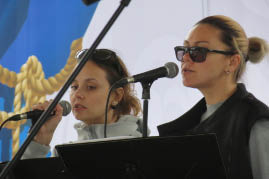
Peterhof |

Peterhof |
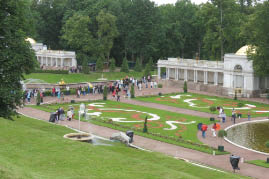
Peterhof |

Peterhof |

All the way to the Gulf of Finland |
Coming back on the bus, we got stuck in awful traffic. The beauty of St. Petersburg at first blew me away … but now, coming back in the traffic, it lost some of its charm. I see mile after mile of worn Khrushchev's slums – once thought of as modern, free apartment buildings to provide free housing for all. What’s it like living in such boxy neighborhoods. The thought of it makes me miss my sweet little Kensington.

Khrushchev Apartments |

Khrushchev Apartments |
We are almost an hour late returning to the ship. Consequently, the Captain’s Cocktail party is delayed. Dinner is also delayed and the concert doesn’t get started until about 10. The two musicians – piano player and an old Russian type banjo -- were wonderful – but over half the audience, including Bill and myself, snoozed most of the time – Shame on us.
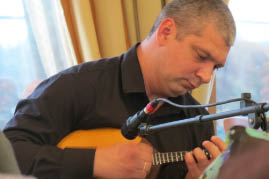
Musician on the Boat |
|











